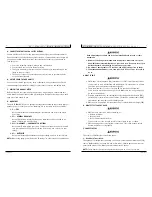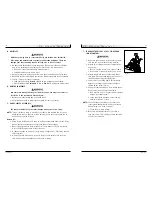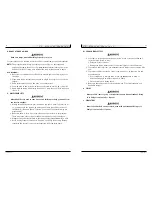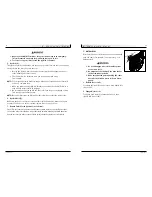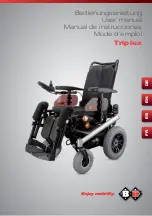
930570 Rev. C
V I . G e n e r a l W a r n i n g s
13
C. WEIGHT LIMIT
1. Never exceed a total weight of either 175 lbs, 250 lbs or 400 lbs, for the rider
plus carried items. The weight capacity of your S-626 is identified by a label
located on the inside cover of the battery compartment door.
2. Never use this chair for weight training if the total weight (rider plus weights
lifted) exceeds the indicated weight capacity of the wheelchair.
3. Exceeding the weight limit is likely to damage the seat, frame or fasteners and
may cause severe injury to you or others from chair failure.
4. Exceeding the weight limit will void the warranty.
D. CONTROLLER SETTINGS
Be aware that you may need to adjust the controller settings of your chair to reduce
the risk of a collision, fall or tip-over.
1. Check and adjust the settings every six to twelve months (or more often,
if needed).
2. Consult your supplier to adjust the control settings immediately if you notice
any change in your ability to:
• Control the joystick.
• Hold your torso erect.
• Avoid running into objects.
E. EMI
Read Section V to learn about EMI. To reduce the risk of unintended brake release or
chair movement:
1. Never turn on or use a hand-held transceiver while power to your chair is on.
Use extra care if you believe that such a device may be in use near your chair.
2. Be aware of nearby radio or TV stations, and avoid coming close to them.
3. If unintended movement or brake release occurs, turn your chair off as soon
as it is safe.
F. SAFETY CHECK-LIST
Before each use of this chair:
1. Make sure the chair operates smoothly. Check for noise, vibration, or a change
in ease of use. (They may indicate low tire pressure, loose fasteners, or damage
to your chair).
• If you detect a problem, make sure to repair or adjust the chair. Deferring
repair or adjustment could increase the risk for injury. Your supplier can
help you find and correct the problem.
2. Make sure batteries are charged. Green lights on charge indicator will light up
when charge is full. Yellow lights indicate battery charge level is getting low.
Red lights indicate batteries are in immediate need of charging.
V I . G e n e r a l W a r n i n g s
930570 Rev. C
12
Heed all warnings in this section. If you fail to do so a fall, tip-over or loss
of control may occur and cause severe injury to your or others.
A. NOTICE TO RIDER
1. Before using this chair, you should be trained in its safe use by your health
care professional.
2. Every wheelchair is different. Take the time to learn the feel of this chair
before you begin riding.
3. Be aware that you must develop your own methods for the safe use of this
chair that are best suited to your level of function and ability.
4. Have someone help you practice bending, reaching and transfering until you
learn how to do them safely.
5.
Never
try a new maneuver on your own unless you are sure it is safe.
6. Get to know the areas where you plan to use your chair. Look for hazards and
learn how to avoid them.
B. NOTICE TO ATTENDANTS
Make sure you heed all warnings and follow all instructions in each section of this
manual. (Be aware that warnings that apply to the rider also apply to you).
Notes:
1. You need to work with the rider, and the rider’s doctor, nurse or therapist, to
develop safe methods best suited to your abilities and those of the rider.
2. To manually push the chair you must release the motor locks.
• Make sure you have full control over the chair when you release the motor
locks. When you do so the chair will not have brakes.
3. Propel this chair by the push handles only. They provide secure points for you
to hold the rear of the chair to prevent a fall or tip-over.
• Check to make sure push handle grips will not rotate or slip off.
Helping The Rider Overcome An Obstacle:
1. To prevent injury to your back, use good posture and proper body mechanics.
When you lift or support the rider or tilt the chair, bend your knees slightly and
keep your back as upright and straight as you can.
2. Before each maneuver, tell the rider what you plan to do, and explain what you
expect the rider to do. This will put the rider at ease and reduce the risk of an
accident.
3. Go straight up and straight down a curb or stair. If you turn, or climb or
descend at an angle, a fall or tip-over is likely.
4. Remind the rider to lean back when you tilt the chair backward.
5. Lower the chair slowly. Do not let the chair drop to the pavement or ground.
Doing so may damage the chair or injure the rider.
Summary of Contents for Quickie S-626
Page 26: ......





